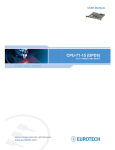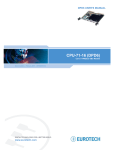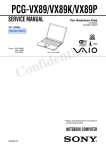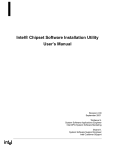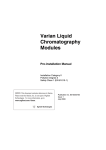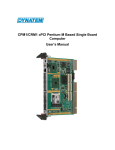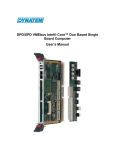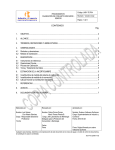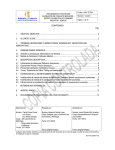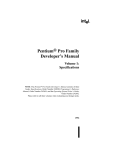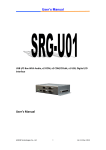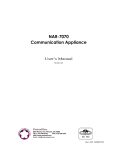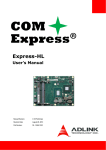Download DMC VMEbus Pentium III Based Dual PMC Module
Transcript
DMC VMEbus Pentium III Based Dual PMC Module Carrier Board User’s Manual DMC User’s Manual Rev. 1.00 June 2003 Dynatem 23263 Madero, Suite C Mission Viejo, CA 92691 Phone: (949) 855-3235 Fax: (949) 770-3481 www.dynatem.com Table of Contents 1. Features 1 2. Related Documents 3 3. Hardware Description 5 3.1 3.2 3.3 3.4 3.5 3.6 3.7 3.8 3.9 3.10 3.11 3.12 3.13 3.14 4. Overview Processor Intel 815E Chipset DRAM Intel 82559 Fast Ethernet Controller Tundra Universe IID CA91C142D PCI-VMEbus Interface PCI Mezzanine Card (PMC) Slot Winbond W823627HF/F Super I/O Device Real Time Clock and NVRAM Intel’s E82802AC Firmware Hub Clock Drivers Reset Circuitry Watchdog Timer Operation Interrupt Logic 19 Installation 4.1 4.2 4.3 4.4 4.5 4.6 Dynatem 5 6 6 6 7 8 11 12 13 13 14 15 16 17 Jumper Selectable Options CompactFlash Drive Installation PCI Mezzanine Card (PMC) Installation VMEbus Chassis Installation Front Panel Connections Front Panel Reset Switch and LEDs DMC VMEbus Pentium Processor Board – User’s Manual 20 23 23 23 24 24 i A. A.1 A.2 A.3 A.4 A.5 A.6 A.7 A.8 A.9 A.10 B. B.1 B.2 B.3 B.4 B.5 C. ii Connector Pin-outs JTAG Debug Port (J4) Floppy Drive Interface Connector (J8) External BIOS Connector Pin-out (J3) 10BaseT/100BaseTX Fast Ethernet Connector (J1) VGA Connector (J2-1) PS/2 Keyboard/Mouse Connector (J2-2) Primary IDE Interface Connector (J7) CompactFlash Interface Connector (J6) PCI Mezzanine Card (PMC) Connectors (JN1 and JN2) VMEbus Connectors (P0, P1, and P2) Address Maps, Interrupts, DMA Channels Memory Map PCI/AGP Configuration Space Map Interrupt Request Routing ISA DMA Channel Assignments PCI Bus Request/Grant Routing Power and Environmental Requirements DMC VMEbus Pentium Processor Board – User’s Manual 25 26 27 28 28 29 29 30 31 32 36 39 39 39 40 41 41 42 Dynatem Chapter 1 – Features 1. Features The Dynatem DMC is a single-slot 6U VMEbus Single Board Computer (SBC). The DMC offers full PC performance with a Socket 370 processor and it also offer two Fast Ethernet ports and two PMC sites for greater expansion capability. The DMC employs Intel’s embedded technology to assure long-term availability. The Socket 370 processor will track commercial product, however, for low cost and high performance. Features of the DMC include: • Single-slot VMEbus operation with on-board CompactFlash disk for bootable mass storage and front panel connectors for Keyboard/Mouse, VGA, and 10/100BaseTX • COM1/2, LPT1, PMC I/O, mouse/keyboard, a second 100BaseTX port, USB, Soundblaster, Game Port, IDE and FDC are routed out to the backplane via a five-row VME64 P2 connector and a P0 connector • Socket 370 supports readily available processors from an 850 MHz Celeron to a 1.4 MHz Tualatin Pentium III Dynatem DMC VMEbus Pentium Processor Board – User’s Manual 1 Chapter 1 – Features • High-performance Intel 815E chipset with DRAM controller, PCI bus arbitration logic and interface, built-in video interface, Ultra ATA IDE interface, USB interface, RTC, NV-RAM, standard PC timers, and interrupt logic. • An SO-DIMM socket supports up to 512 MB of SDRAM at 133 MHz • Tundra Universe IID PCI-VMEbus Interface provides 64-bit VMEbus transfer rates over 30 MB/sec. Integral FIFOs permit write-posting to maximize available PCI and VMEbus bandwidth. Full Slot 1 (System Controller) functionality is provided • Two Intel’s 82559 Fast Ethernet Controllers with 10/100BaseTX support • Two PCI Mezzanine Cards (PMC) are supported with front panel I/O, while maintaining VMEbus single-slot form factor • Primary Ultra DMA IDE Interface with improved transfer rates and PIO and Bus Master support • Secondary IDE port for CompactFlash on-board booting for flash-based and mechanical storage • General Software’s flash-based system BIOS • Floppy drive controller with support for drives of up to 2.88 MB • COM1 and COM2 serial ports, based on 16C550 compatible UARTs with 16-byte transmit and receive FIFOs • LPT1 parallel port that’s capable of standard, bidirectional, enhanced parallel port (EPP), and enhanced capabilities port (ECP) operation, with IEEE 1284 compliance. • Programmable watchdog timer for system recovery. • Operating System (OS) and driver support, including Windows NT, Embedded NT, QNX, VxWorks, Linux, Solaris, and pSOS+. 2 DMC VMEbus Pentium Processor Board – User’s Manual Dynatem Chapter 2 – Related Documents 2. Related Documents Listed below are documents that describe the Pentium processor and chipset, and the peripheral components used on the DMC. Contact your local distributor for copies of these documents. For a data sheet on the Pentium III, go to: http://developer.intel.com/design/intarch/pentiumiii/pentiumiii.htm For a data sheet on the Celeron, go to: http://developer.intel.com/design/intarch/celeron/celeron.htm For Intel data, go to: http://developer.intel.com/design/litcentr/index.htm The Intel website is subject to change but the following documents should be available and downloadable: • Pentium ® III Processor for the PGA370 Socket at 500 MHz to 1.13 GHz ftp://download.intel.com/design/PentiumIII/datashts/24526408.pdf • Intel ® Celeron ® Processor for the PGA370 Socket up to 1.40 GHz on 0.13 Micron Proces ftp://download.intel.com/design/celeron/datashts/29859604.pdf • Intel ® 82801BA I/O ControllerHub 2 (ICH2) and Intel ® 82801BAMI/O Controller Hub 2 Mobile(ICH2-M) http://developer.intel.com/design/chipsets/datashts/290687.htm • Intel Chipset Family: 82815 Graphics and Memory ControllerHub (GMCH) ftp://download.intel.com/design/chipsets/datashts/29068801.pdf • 82559ER Fast Ethernet PCI Controller http://developer.intel.com/design/network/products/lan/controllers/82559er.htm • VMEbus Interface Components Manual Tundra Semiconductor Corporation; Universe IID revisions are found at www.tundra.com • Winbond W83627HF/F Super I/O Device Data Sheet Winbond’s website is http://www.winbond.com.tw/e-winbondhtm/index.asp Dynatem DMC VMEbus Pentium Processor Board – User’s Manual 3 Chapter 2 – Related Documents • The following documents provide information on the PC architecture: • PCI Local Bus Specification, Revision 2.1 PCI Special Interest Group The following documents cover topics relevant to the VMEbus and can be purchased through VITA: • IEEE Std 1014-1987, IEEE Standard for a Versatile Backplane Bus: VMEbus The Institute of Electrical and Electronic Engineers 345 East 47th Street New York, NY 10017 (800) 678-4333 • Wade D. Peterson, The VMEbus Handbook VITA 10229 North Scottsdale Road, Suite B Scottsdale, AZ 85253 (480) 951-8866 The following documents are the current draft standards for the PCI Mezzanine Card (PMC): • IEEE Draft Std P1386/2.0, Draft Standard for a Common Mezzanine Card Family: CMC The Institute of Electrical and Electronic Engineers 345 East 47th Street New York, NY 10017 (800) 678-4333 • IEEE Draft Std P1386.1/2.0, Draft Standard Physical and Environmental Layers for PCI Mezzanine Cards: PMC The Institute of Electrical and Electronic Engineers 345 East 47th Street New York, NY 10017 (800) 678-4333 4 DMC VMEbus Pentium Processor Board – User’s Manual Dynatem Chapter 3 – Hardware Description 3. Hardware Description 3.1 Overview The block diagram of the DMC is shown below. The sections that follow describe the major functional blocks of the DMC. Socket 370 supports Tualatin PIII Processors and Celeron Processors Integrated 3D Graphics Controller VGA Port ← 133 MHz 64-bit GTL Bus Graphics and Memory Controller Hub (GMCH) PCI Mezzanine Card #1 64-bit Memory Bus @ up to 133 MHz PCI Mezzanine Card #2 SO-DIMM Socket (J5) supports up to 512 MBytes of SDRAM Intel 82559ER Fast Ethernet #1 VMEbus Intel 82559ER Fast Ethernet #2 Tundra Universe IID VMEbus 5 Volt tolerant 33 MHz 32-bit PCIbus Clock Drivers I/O Controller Hub (ICH2) USB, AC ‘97, IDE, & Compact Flash BIOS/ Firmware Hub Reset Circuitry Winbond W83627HF Super I/O Interrupt Logic FDC, Mouse/Keyboard, LPT1, & COM1/2 Ports Hub Interface DMC Block Diagram Dynatem DMC VMEbus Pentium Processor Board – User’s Manual 5 Chapter 3 – Hardware Description 3.2 Processor The DMC supports a Socket 370 processor. Both Tualatin Pentium III’s and Celeron processors are supported. • Processor System Bus (PSB) of up to 133 MHz. • Built-in Level 1 instruction (code) and data caches of 16 KB each and up to 512 KB of on-die L2 cache. • Integrated math co-processor. • Power management, MMX, and backwards compatibility with Pentium class processors. For further information on the Pentium processor, refer to Pentium Processors and Related Products, available from Intel Corporation. 3.3 Intel 815E Chipset With the 2nd generation I/O Controller Hub (ICH2), the Intel® 815E chipset offers greater platform flexibility and stability in Celeron® and Pentium® III processor-based PCs. The Intel 815E chipset consists of two devices: Graphics and Memory Controller Hub (GMCH) and the I/O Controller Hub (ICH2). The GMCH integrates the following functions into a single ball-grid array (BGA) package: • Built-in graphics accelerator which supports VGA resolutions up to 1600 x 1200. • 133 MHz DRAM controller supporting up to 512 MB of Synchronous DRAM (SDRAM) which are accessed from an on-board SO-DIMM connector. • 133 MHz 64 bit front side processor bus. The ICH2 integrates the following functions into a single ball-grid array (BGA) package: • PCI 2.2 compliant, high-performance Processor-to-PCI buffered bridge with PCI bus arbitration logic. • USB support and AC’97 2.1 compliant link for audio and telephony codecs. • Primary and secondary Ultra ATA/100/66/33 interfaces. The IDE signals are brought out to J7 and J6. The primary IDE port, J7, is a 44-pin dual-row 2-mm header on the PCB. The secondary port, J6, is a CompactFlash Type II connector. The pin-outs for these connectors are given in Appendix A. • Enhanced DMA controller, interrupt controller, and timer functions. For further information, see the documents referenced in Section 2. 3.4 DRAM The DMC supports up to 512 MB of Synchronous DRAM (SDRAM) with a 144-pin SO-DIMM socket for additional 3.3 V PC100 SDRAM memory. When a processor with a front side bus of 133 MHz is populated in the DMC’s socket 370, SO-DIMM’s compliant with PC133 (133 MHz transfer rates) may be installed. Jumpers JP1 and JP2 determine the frequency of the front side bus and the SO-DIMM’s DRAM interface. The SO-DIMM socket is J5 and it is located beneath the two PMC modules. While these SO-DIMM’s are industry standard, we recommend ordering this DRAM from Dynatem as it will be tested at the factory for electronic and mechanical compatibility. 6 DMC VMEbus Pentium Processor Board – User’s Manual Dynatem Chapter 3 – Hardware Description 3.5 Intel 82559 Fast Ethernet Controller The DMC provides two 82559 Fast Ethernet controllers. The Intel 82559 offers the following features: • 10BaseT and 100BaseTX support with auto-negotiation. • Independent 3 KB receive and transmit FIFOs. • Powerful on-chip DMA minimizes CPU overhead with zero wait-state burst transfers to system memory. • Built-in Phyceiver. • Serial EEPROM for nonvolatile Ethernet address storage. The 10BaseT/100BaseTX signals of one of the 82559 controllers are brought out to J1, an RJ-45 connector on the front panel. The pin-out for J1 is given in Appendix A. Three front panel LEDs are located below the front panel reset button and are controlled by the Ethernet circuitry: CR1 is closest to the RJ-45 connector (it is on when transferring at 100 Mb/sec, off when transferring at 10 Mb/sec), CR2 (active) is positioned next, and CR3 (link established) is the last indicator LED for the first Ethernet port. The DMC’s second 82559 has its I/O lines routed to VMEbus connector P2. Both Dynatem’s rear I/O breakout card (model XMCPTB) and the 2nd-slot mass storage transition module (model XMCTB) run these lines through a transformer and out an RJ-45 connector. Indicator LED’s for the second LAN port are located next to those for the first port, below the reset button. These three LED’s follow the same pattern as those for the first port. The Intel 82559 contains several PCI configuration registers. It also contains a number of device registers for controlling the Ethernet operation that can be mapped to the memory space or the I/O space. The PCI signals specific to the DMC’s first 82559 are shown below: Intel 82559 Signal PCI Bus Connection IDSEL PREQ PGNT PIRQ AD23 (PCI Device 0Ch) REQ2# (ICH2) GNT2# (ICH2) PIRQH# (ICH2) The PCI signals specific to the DMC’s second 82559 are shown below: Intel 82559 Signal PCI Bus Connection IDSEL PREQ PGNT PIRQ AD24 (PCI Device 0Ch) REQ3# (ICH2) GNT3# (ICH2) PIRQG# (ICH2) For further information on the 82559, refer to 82559 Fast Ethernet Multifunction PCI/Cardbus Controller, available from Intel Corporation. Please go to the link at: http://developer.intel.com/design/network/products/lan/controllers/82559.htm Dynatem DMC VMEbus Pentium Processor Board – User’s Manual 7 Chapter 3 – Hardware Description 3.6 Tundra Universe IID CA91C142D PCI-VMEbus Interface The PCI-VMEbus interface, based on the Tundra Universe IID CA91C142D, offers the following features: • High-performance 64-bit VMEbus interface. • Integral FIFOs for write-posting allow the Universe IID to quickly relinquish the bus. • Programmable DMA controller with linked list support. • Full VMEbus system controller functionality. • Complete VMEbus address and data transfer modes: • • A32/A24/A16 master and slave • D64 (MBLT)/D32/D16/D08 master and slave Flexible register set, programmable from both the PCI bus and the VMEbus. The block diagram of the PCI-VMEbus interface is shown below: VMEbus A01 – A31, LWORD* Buffers PCI Bus A24 – A31 D00 – D31 AD[31:0] AD27 Buffers D16 – D31 AS, DS0*, DS1*, Ctrl IDSEL Buffers C/BE[3:0], Ctrl AM0* – AM5* Buffers Universe IID CA91C142D LINT0# LINT1# Reset Circuitry 815E Chipset IRQx*, BRx* Buffers PCI REQ4#, GNT4# VMEbus P1 Connector PMC#2 I/O, COM2, USB, CODEC VMEbus P0 Connector VMEbus P2 Connector IDE P2 User Defined Pins COM1 LPT1 PMC#1 I/O PCI-VMEbus Interface Block Diagram 8 DMC VMEbus Pentium Processor Board – User’s Manual Dynatem Chapter 3 – Hardware Description As shown in the block diagram, several peripheral signals are routed to the user-defined pins of the VMEbus P2 connector. The VMEbus P1 and P2 connector pin-outs are given in Appendix A. The Universe IID CA91C142D can act as a PCI bus initiator (master) or target (slave), and a VMEbus master or slave. The Universe IID is capable of generating interrupts on the VMEbus, and can act as a VMEbus interrupt handler. The Universe IID provides full VMEbus system controller functionality. The DMC reset circuitry is tied to the Universe IID, since the DMC can generate the VMEbus SYSRESET* signal as well as be reset by another VMEbus board that asserts the SYSRESET* signal. The DMC reset circuitry is discussed in detail in Section 3.12. This section is intended to supplement the VME-to-PCI Bus Bridge Manual User Manual (downloadable from www.tundra.com), which contains comprehensive descriptions of the operation and programming of the Universe IID. In that manual, Chapter 1, Functional Overview, Chapter 5, Registers Overview, and Chapter 12, Registers, provide the necessary information to understand the operating modes of the Universe IID: • DMC-initiated transfers (PCI slave, VMEbus master). • Other VMEbus master-initiated transfers (PCI master, VMEbus slave). • DMA controller transfers (PCI master, VMEbus master). • VMEbus interrupt generation. • VMEbus interrupt handling. • System controller functionality. • Register programming via the PCI bus and the VMEbus. • Coupled and uncoupled transfers between the PCI bus and the VMEbus. • 4 mailboxes and 8 semaphores. • VMEbus arbitration. The Universe IID Control and Status Registers (UCSRs) are used for the configuration of the Universe IID. These registers form a 4 KB block, divided into three groups: • PCI Configuration Space (PCICS). • Universe IID Device Specific Status Registers (UDSRs). • VMEbus Control and Status Registers (VCSRs). These registers are accessible (to varying degrees) via three address spaces: • PCI Configuration Space – Only the PCICS register block is accessible in this space. • PCI Memory Space – The entire 4 KB UCSR block is accessible in this space. • VMEbus A32/A24/A16 Space – The entire 4 KB UCSR block is accessible in this space. Dynatem DMC VMEbus Pentium Processor Board – User’s Manual 9 Chapter 3 – Hardware Description During initialization, the system BIOS maps PCI peripherals that require space beyond the PCI configuration space into the memory space or I/O space. The Universe IID UCSR block is 4 KB in size and must be aligned on a 64 KB boundary. The total I/O space of an Intel processor is 64 KB and many of the common PC peripherals are found in the first 1 KB of this space. Thus, a request for a 64 KB block of I/O space for the Universe IID registers would be denied by the system BIOS, leaving the Universe IID unmapped. To avoid this situation, the Universe IID offers a power-up option to map its registers into the memory space. This is accomplished on the DMC by tying the VA[1] line high via a pull-up resistor. There are two mechanisms to access the UCSR block from the VMEbus. The first is the VMEbus Register Access Image (VRAI) method, which is defined by the following registers in the Universe IID User’s Manual: Field Register Bits Description Address Space Base Address Slave Image Enable Mode Type VAS in Table A.76 BS[31:12] in Table A.77 EN in Table A.76 SUPER in Table A.76 PGM in Table A.76 A32, A24, or A16 Lowest address in the 4 KB slave image Enable VMEbus Register Access Image Supervisor and/or Non-Privileged Program and/or Data The reset state of the VAS, BS[31:12], and EN fields can be configured as power-up options. On the DMC, all of these fields reset to 0. Thus, the VRAI method must be configured and enabled by accessing the Universe IID registers in the memory space. The second mechanism for accessing the UCSR block from the VMEbus is the CS/CSR method, which is defined by the following registers in the Universe IID section of the User’s Manual: Field Register Bits Description Base Address Slave Image Enable BS[23:19] in Table A.84 EN in Table A.78 Base address of Universe IID 512 KB slot Enable CS/CSR image The BS[23:19] and EN fields reset to all 0s, and the EN bit can be set by the VME64 Auto ID process. Thus, the CR/CSR method must be configured by accessing the Universe IID registers in the memory space. The PCI signals specific to the Tundra Universe IID CA91C142D are shown below: 10 Tundra Universe IID CA91C142D Signal PCI Bus Connection IDSEL REQ# GNT# LINT0# LINT1# AD27 (PCI Device 10h) REQ4# (ICH2) GNT4# (ICH2) PIRQG# (ICH2) EXTSMI# (ICH2) DMC VMEbus Pentium Processor Board – User’s Manual Dynatem Chapter 3 – Hardware Description 3.7 PCI Mezzanine Card (PMC) Slots The DMC offers two PCI Mezzanine Card (PMC) sites for more flexible I/O expansion. The first PMC site (designated PMC #1) is closer to the Socket 370 processor and its heat sink. The PMC Slot offers the following characteristics: • Conforms to IEEE draft standards 1386/2.0 and 1386.1/2.0. • Accepts single-width 5V PMC boards with front panel I/O as well as backplane I/O. • Provides 32-bit PCI support via connectors JN1 and JN2, and JN4 is available for routing PMC I/O to VMEbus connector P2. The two PMC sites do not offer JN3 connectors for 64-bit PCI support, but cards containing a PN3 connector are accommodated (that is, no components on the DMC interfere with a PMC PN3 connector). The PCI signals specific to the two PMC Slots are shown below: PMC #1 Slot Signal PCI Bus Connection IDSEL REQ# GNT# PMCINTA# PMCINTB# PMCINTC# PMCINTD# AD16 (PCI Device 0Fh) REQ0# (ICH2) GNT0# (ICH2) PIRQA# (ICH2) PIRQB# (ICH2) PIRQC# (ICH2) PIRQD# (ICH2) PMC #2 Slot Signal PCI Bus Connection IDSEL REQ# GNT# PMCINTA# PMCINTB# PMCINTC# PMCINTD# AD17 (PCI Device 0Fh) REQ1# (ICH2) GNT1# (ICH2) PIRQB# (ICH2) PIRQC# (ICH2) PIRQD# (ICH2) PIRQA# (ICH2) The DMC routes most of the JN4 I/O pins of the two PMC sites to the VMEbus backplane. With PMC #1, pins 1 through 46 of its JN4 I/O connector are routed to the P2 VMEbus connector. With PMC #2, pins 1 through 60 of its JN4 I/O connector are routed to the P0 VMEbus connector. Depending on whether the integrator’s I/O will be routed to the backplane, on how many of those JN4 I/O pins are needed, and whether a VME64 Extensions backplane (with P0 support) is used, care should be taken regarding site assignment. Appendix A has the pinouts for VMEbus backplane connectors P0 and P2. For further information on the PMC specification, refer to PCI Local Bus Specification, Revision 2.2, available from the PCI Special Interest Group (www.pcisig.com), IEEE Draft Std P1386-2001, IEEE Standard for a Common Mezzanine Card Family: CMC, and IEEE Draft Std P1386.1-2001, IEEE Standard Physical and Environmental Layers for PCI Mezzanine Cards: PMC, both available from the Institute of Electrical and Electronic Engineers. Dynatem DMC VMEbus Pentium Processor Board – User’s Manual 11 Chapter 3 – Hardware Description 3.8 Winbond W83627HF/F Super I/O Device The Winbond W83627HF/F provides the following standard PC peripherals: • Floppy drive controller with support for drives up to 2.88 MB with a 2Mbps transfer rate. • COM1 and COM2 serial ports, based on 16C550 compatible UARTs with 16-byte transmit and receive FIFOs. • LPT1 parallel port that’s capable of standard, bidirectional, enhanced parallel port (EPP), and enhanced capabilities port (ECP) operation, with IEEE 1284 compliance. • Infrared port that supports IrDA version 1.0 SIR protocol with maximum baud rate up to 115.2K bps The W83627HF/F clock input is driven by a 24 MHz clock and it uses the Low Pin Count (LPC) interface with the 815E chipset. The COM1 and LPT1 signals are routed to the user defined pins of the VMEbus P2 connector. The floppy drive signals are routed to J8, a 1.00mm ZIF flex circuit connector on the PCB and they can optionally be routed to P2 when jumpers JP5 through JP16 are closed. The COM2, CODEC, Joystick, and IR signals are brought out to VMEbus connector P0. The connector pin-outs are given in Appendix A. The Winbond W83627HF I/O space addresses upon power-up or reset are shown below: Winbond W83627HF/F I/O Address Configuration COM1 COM2 Parallel Port Floppy Drive Interface 3F0, 3F1 3F8 - 3FF 2F8 - 2FF 278 - 27F 3F0 - 3F7 The W83627HF defaults to LPT2 (278-27F) upon power-up or reset, but the system BIOS can reconfigure the parallel port for operation as LPT1 (378-37F), LPT2 (278-27F), or LPT3 (3BC-3BF). Thus, throughout this manual the parallel port is referred to as LPT1. The Winbond W83627HF interrupt request line assignments are shown below: Winbond W83627HF/F Function Interrupt Request Line COM2, COM4 COM1, COM3 LPT2 Floppy LPT1 IRQ3 IRQ4 IRQ5 IRQ6 IRQ7 The Winbond W83627HF DMA channel assignments are shown below: 12 Winbond W83627HF/F Function DMA Channel Floppy Parallel Port (ECP mode) DMA Channel 2 DMA Channel 5 DMC VMEbus Pentium Processor Board – User’s Manual Dynatem Chapter 3 – Hardware Description The keyboard/mouse controller, based on the Intel 8042, is built-in to the W83627HF and it is a standard 8-bit ISA peripheral for controlling a PS/2 style keyboard and a PS/2 style mouse. Power is supplied to the keyboard and mouse via a 1 amp self-resetting fuse (F1). The keyboard and mouse signals are routed to J2-2, which is a 6-pin mini-DIN receptacle on the front panel. The pin-out of J2-2 is given in Appendix A. The W83627HF’s keyboard/mouse controller I/O space addresses are shown below: W83627HF’s Keyboard/Mouse Controller Register I/O Address Keyboard/Mouse Data Keyboard/Mouse Status/Command 60 64 The W83627HF’s keyboard/mouse controller interrupt request line assignments are shown below: W83627HF’s Keyboard/Mouse Controller Function Interrupt Request Line Keyboard Buffer Full Mouse Buffer Full IRQ1 IRQ12 For further information on the W83627HF, refer to the W83627HF Data Sheet, available from Winbond, their website is at http://www.winbond.com.tw/e-winbondhtm/index.asp 3.9 Real Time Clock and NVRAM Both the Real Time Clock (RTC) and the NVRAM for holding battery-backed BIOS parameters are contained within the FW82801BA I/O Controller Hub 2 (ICH2). The RTC generates IRQ8. NVRAM addresses use I/O address 70 while NVRAM data use I/O address 71. The ICH2 is battery-backed by an on-board lithium coin cell. 3.10 Intel’s E82802AC Firmware Hub The Intel E82802AC uses a 5-pin interface and provides 8 Mb of flash memory for the system BIOS. This device can fill the 1 MB real mode memory map so only a portion, the upper 256 MB, is used. The E82802AC’s 1 MB of memory space is segmented into sixteen parameter blocks of 64 KB each. The DMC powers up into real mode and the BIOS is eventually shadowed into system DRAM after booting through the BIOS. Here is how the ICH2 chip maps the real mode: The FW82801BA (ICH2) provides the 5-pin interface to the E82802AC. The upper 256 KB of the E82802AC is located from 000C0000 - 000FFFFF (the top of 1 MB) and its full 1 MB of memory is aliased from FFF00000 – FFFFFFFF where it can be fully accessed after booting up through the BIOS. Dynatem DMC VMEbus Pentium Processor Board – User’s Manual 13 Chapter 3 – Hardware Description 3.11 Clock Drivers The clock driver circuitry is shown below: ICS 9250-28 14.31818 MHz Crystal 32.768 KHz Crystal DRAM can be 100 or 133 MHz, CPU Clock can be 66, 100, or 133MHz To ICH2 for Real Time Clock 33 MHz CPU To Socket 370 and GMCH To SDRAM Clocks To APIC in ICH2 To ICH2 PCICLK To Intel 82559 #1 PCI CLK 25.0 MHz Oscillator x2 To Ethernet Transceivers 33 MHz (from an ICS 9112B) To Intel 82559 #2 PCI CLK To Universe IID LCLK To PMC Slot #1 PCI CLK To PMC Slot #2 PCI CLK 64.0 MHz Oscillator To Universe IID CLK64 48 MHz To USB circuit in ICH2 To Super I/O 2 Hub Clocks for GMCH & ICH2 66 MHz Video Clock to GMCH Clock Driver Circuitry The clock driver circuitry is based on the ICS 9250 and the ICS 9112B (the 9112B is used to generate multiple PCI clocks at 33 MHz), driven by a 14.31818 MHz crystal. A 32.768 KHz Crystal drives the Real Time Clock (RTC) to the ICH2, two separate 25.0 MHz oscillators drive the two Ethernet ports, and a 64.0 MHz oscillator drives the Universe IID CA91C142D VMEbus circuitry. The CPU and DRAM clocks, as indicated in the drawing above, are configurable. Jumpers JP1 & JP2 determine these clock rates. 14 DMC VMEbus Pentium Processor Board – User’s Manual Dynatem Chapter 3 – Hardware Description 3.12 Reset Circuitry The reset circuitry is shown below: Universe IID CA91C142D Pull-up VMEbus SYSRESET VME_RESET# VXSYSRST SW1-3 MISC_CTL[SW_SYSRST] VRSYSRST# MISC_CTL[SW_LRST] LRST# Front Panel Reset Switch +5 VDC Monitor VCSR_SET[RESET] VCSR_CLR[RESET] DS1232 PWRRST# RST# Watchdog Strobe NAND Gate Reset Registers, State Machines SW1-2 ICH2 PWROK WDCLKEN General Purpose Output Register Ethernet #1 Clock Reset Control Register PCIRST# PCI peripherals CPURST Pentium “hard” reset INIT Pentium “soft” reset Reset Circuitry Opening SW1-3 will prevent the DMC’s hard reset from resetting the VMEbus backplane (see next page). Opening SW1-2 will isolate the DMC from VMEbus SYSRESETs. Either SW1-3 or SW1-2 should be closed – but never both at the same time. Dynatem DMC VMEbus Pentium Processor Board – User’s Manual 15 Chapter 3 – Hardware Description There are eight ways to perform a hard reset of the DMC: • The DS1232 senses that the +5 VDC supply has dropped too low, which asserts a PWROK signal to the ICH2, the Super I/O, and to the Universe IID. This signal resets the processor and the Chipset and, ultimately, all PCI peripherals. • The front panel reset switch is pressed, which also asserts a PWROK signal and resets the DMC. • Another VMEbus board asserts SYSRESET*, which asserts the Universe IID VRSYSRST# input and, if switch SW1-2 is closed, will reset the DMC via the DS1232. • The SW_SYSRST bit in the MISC_CTL register of the Universe IID is set by code running on the DMC processor. This leads to the assertion of the VMEbus SYSRESET* signal, if SW1-3 is closed. • The SW_LRST bit in the MISC_CTL register of the Universe IID is set by code running on the DMC processor. This performs a local hard reset of the DMC board circuitry, if SW1-2 is closed, without asserting the VMEbus SYSRESET* signal. • Another VMEbus master sets the RESET bit in the VCSR_SET register of the Universe IID over the VMEbus. In this case the LRST# signals remains asserted until the RESET bit of the VCSR_CLR register of the Universe IID is set by another VMEbus master over the VMEbus. • The Reset Control Register in the ICH2 can be set appropriately by code running on the DMC processor. • Let the watchdog timer time out; see Section 3.13 below. For further information on the peripherals that play a part in the reset circuitry, refer to Intel ® 82801BA I/O ControllerHub 2 (ICH2) and Intel ® 82801BAM I/O Controller Hub 2 Mobile (ICH2-M) from Intel Corporation, Document Number 290687-002, and Intel815 Chipset Family: 82815 Graphics and Memory Controller Hub (GMCH), also available from Intel Corporation at www.intel.com. 3.13 Watchdog Timer Operation The DMC’s DS1232 is used to reset the entire board through the push button accessed through the front panel, through the module’s 5 VDC supply being sensed as dropping to 4.75 VDC, through a VMEbus reset if jumper SW1-2 is closed, or if the watchdog timer is enabled and it times out. The DMC’s watchdog timer is controlled by one general-purpose output line (GPO19) that is asserted by the ICH2. The DS1232 has a strobe input pin which must see an active clock. If no clock pulse is generated to the pin within 500 milliseconds, the entire DMC board will be reset. As long as GPO19 is high, a 25 MHz clock will be present at the strobe input. To use the watchdog timer, drive GPO19 low, thereby turning off the 25 MHz clock to the DS1232’s strobe input, but write a software routine that will bring GPO19 high before 500 milliseconds elapses. GPO19 is controlled by bit 19 in the ICH2’s GP_LVL register. GPO19 reflects the status of bit 19: GPO19 is high if bit 19 is a logic 1 and it is low of bit 19 is at logic 0. GPO19 is high at reset so the watchdog timer will only be activated when the user drives bit 19 of the GP_LVL register low. 16 DMC VMEbus Pentium Processor Board – User’s Manual Dynatem Chapter 3 – Hardware Description 3.14 Interrupt Logic The interrupt logic is shown below: ICH2 Keyboard IRQ1 COM2/COM4 (W83627HF) IRQ3 COM1/COM3 (W83627HF) IRQ4 LPT2 (W83627HF) IRQ5 Floppy Drive (W83627HF) IRQ6 Unused IRQ7 Unused IRQ8# Unused IRQ9 Unused IRQ10 Unused IRQ11 Mouse IRQ12/M Primary IDE Interface (ICH2) IRQ14 CompactFlash / 2ndary IDE IRQ15 PMCINTA# ( PMC Channel 1) or PMCINTB# (PMC #2) PIRQA# PMCINTB# ( PMC #1) or PMCINTC# (PMC #2) PIRQB# PMCINTC# ( PMC #1) or PMCINTD# (PMC #2) PIRQC# PMCINTD# ( PMC #1) or PMCINTA# (PMC #2) PIRQD# Pulled up Socket 370 INTR INTR NMI NMI SMI# SMI# PIRQE# Tundra Universe IID LINT0# PIRQF# 82559 Fast Ethernet Controller #1 PIRQG# 82559 Fast Ethernet Controller #2 PIRQH# IGNNE# IGNNE# FERR# FERR# Interrupt Logic The DMC follows the standard PC ISA interrupt assignments. Logic in the ICH2 can steer the four PCI interrupts to selected ISA interrupts. The Universe IID CA91C142D is capable of acting as an interrupter and interrupt handler for the VMEbus, and can generate PCI interrupts in response to VMEbus interrupts, VMEbus ACFAIL* being asserted, VMEbus SYSFAIL* being asserted, and various internal conditions and errors. Of the eight Universe IID LINT7# - LINT0# outputs, LINT0# is routed to the ICH2 PIRQF# input, LINT1# is pulled up with a 10K resistor, and LINT#[7:2] are pulled up via 8.2K resistors. Dynatem DMC VMEbus Pentium Processor Board – User’s Manual 17 Chapter 3 – Hardware Description 18 DMC VMEbus Pentium Processor Board – User’s Manual Dynatem Chapter 4 - Installation 4. Installation The following sections cover the steps necessary to configure the DMC and install it into a VMEbus system for single-slot operation. This chapter should be read in its entirety before proceeding with the installation. This chapter does not discuss the installation of the DMC with the optional DxC1TB Transition Board or the connection of peripherals accessible via the DxC1TB (primary IDE, floppy drive, Ultra Wide SCSI, COM2, LPT1, and PC speaker). For information on installing the DMC with the DxC1TB Transition Board, refer to DxC1TB Transition Board User’s Manual, available from Dynatem. Neither will I/O expansion via the rear plug-in module, the XPC2PTB, be discussed in detail. The diagram below shows the DMC with no PMC Cards. The sections and connectors of the DMC referred to in this chapter are pointed out. The connectors that do not go to the front panel have their pin 1 location labeled. The off-board BIOS connector is for factory use. The photo above shows the DMC with a DIMM memory module and CompactFlash Drive installed. The DMC is shipped in an antistatic bag. Be sure to observe proper handling procedures during the configuration and installation process, to avoid damage due to electrostatic discharge (ESD). The DMC uses a heavy heat sink for cooling the Socket 370 processor. The 1.4 MHz Tualatin Pentium III CPU is a high performance device that draws a lot of current and, consequently, requires a lot of cooling. Dynatem DMC VMEbus Pentium Processor Board – User’s Manual 19 Chapter 4 - Installation 4.1 Jumper Selectable Options The DMC contains nine jumpers that the user should be familiar with. These jumpers are shown in the drawing below: SW1 JP1, JP2 JP3, JP4 JP5 – JP16 JP5 through JP16 will route the floppy controller’s interface signals to the outer rows of the VMEbus P2 connector. This is an option that is not on the standard board. The following table summarizes all of the on-board jumpers. 20 DMC VMEbus Pentium Processor Board – User’s Manual Dynatem Chapter 4 - Installation The DMC offers a number of user configurable hardware options. These are set by attaching shunts to jumpers or by setting the eight position piano switch Switch 1 (SW1). Jumpers Description JP1 JP2 JP3 JP4 JP5 JP6 JP7 JP8 JP9 JP10 JP11 JP12 JP13 JP14 JP15 JP16 With JP2, this jumper sets the clock rates of the SDRAM interface and CPU’s Front Side Bus (FSB). With JP1, this jumper sets the clock rates of the SDRAM I/F and CPU’s FSB. Optional 2-pin header for routing to a thermal diode for heat sensing. For Battery Backed RTC/NVRAM. Normal: 1 & 2, to clear: 2 & 3 To route FDC line -RDATA to P2.D24 instead of PMC I/O To route FDC line -HDSEL to P2.Z23 instead of PMC I/O To route FDC line –TRK0 to P2.Z25 instead of PMC I/O To route FDC line -WPT to P2.D25 instead of PMC I/O To route FDC line -WDATA to P2.D27 instead of PMC I/O To route FDC line -WGATE to P2.D26 instead of PMC I/O To route FDC line -DIR to P2.D28 instead of PMC I/O To route FDC line -STEP to P2.Z27 instead of PMC I/O To route FDC line -DSKCHG to P2.Z29 instead of PMC I/O To route FDC line –MOTR0 to P2D29 instead of PMC I/O To route Floppy Disk line -INDEX to P2.Z31 instead of PMC I/O To route FDC line -DRVS0 to P2.D30 instead of PMC I/O Switch 1 Description SW1-1 SW1-2 SW1-3 SW1-4 SW1-5 SW1-6 SW1-7 VMEbus Slot 1 Controller when open DMC is reset by the VMEbus SYSRESET when closed Close to permit the Universe IID to reset the VMEbus with SYSRESET For Factory use. User should keep closed. Force CPU to freq strap to safe mode when open. User should keep open. No reboot on 2nd ICH2 Watchdog timeout when closed. Close when an XPC2PTB with CODEC support is used. Jumpers JP1 and JP2 determine both the clock speed of the DRAM interface and the clock rate of the processor’s front side bus. These jumpers will be set appropriately at the factory and they should not be changed. Jumper positions and host bus and DRAM clocks are provided in the following truth table: JP1 JP2 Front Side Bus Clock DRAM Clock 1-2 1-2 2-3 2-3 1-2 2-3 1-2 2-3 133 MHz 100 MHz 133 MHz 66 MHz 100 MHz 100 MHz 133 MHz 100 MHz Jumper JP3 is available for a possible thermal sensor add-on module. Dynatem DMC VMEbus Pentium Processor Board – User’s Manual 21 Chapter 4 - Installation Jumper JP4 is provided for clearing the NVRAM. If BIOS parameters are modified and the DMC goes into a failure mode, default variables can be restored by grounding the battery supply voltage going to the NVRAM and the RTC. This is done by momentarily shunting pins 2 & 3 of JP4 when power is off. When JP4 is shunted between pins 1 & 2, the RTC and the NVRAM draw supply voltage from the lithium coin cell on-board. As with all jumpers, pin 1 can be identified as having a square pad on the solder side of the printed circuit board. NVRAM / RTC Battery Source JP4 Draw Battery Voltage from On-board Coin Cell Clear NVRAM & RTC (While Powered Down) Battery Voltage Supply Selection 1-2 2-3 Jumpers JP5 – JP16 should be shunted if the user wishes to route the floppy disk interface to the P2 connector. Most likely this would be used with Dynatem’s XPC2PTB rear plug-in module that provides a floppy disk connector for routing from behind the backplane. When a VMEbus module occupies slot 1 of the VMEbus chassis (the slot to the extreme left), it must behave as system controller (act as multiprocessing arbiter and generate utility bus signals). Switch SW1-1 configures the VMEbus System Controller functionality of the Universe IID, as shown below: VMEbus System Controller SW1-1 Enabled Disabled VMEbus System Controller Configuration Open Closed Switch SW1-2 lets VMEbus SYSRESET’s reset the DMC when closed. When open, VMEbus SYSRESETs from other modules will not impact the DMC. VMEbus SYSRESET In Selection SW1-2 DMC Won’t Receive SYSRESET’s from the VMEbus DMC Receives SYSRESET’s from the VMEbus VMEbus SYSRESET In Selection Open Closed Switch SW1-3 lets DMC SYSRESETs reset the VMEbus when closed. When open, the DMC cannot drive SYSRESETs to other modules on the VMEbus. The Universe IID only drives SYSRESET when the DMC is a Slot 1 Controller. VMEbus SYSRESET Out Selection DMC Won’t Drive SYSRESETs to the VMEbus DMC Drives SYSRESETs to the VMEbus VMEbus SYSRESET Out Selection 22 SW1-3 Open Closed DMC VMEbus Pentium Processor Board – User’s Manual Dynatem Chapter 4 - Installation 4.2 CompactFlash Drive Installation The DMC supports a bootable CompactFlash Drive for booting into an Operating System (OS) while occupying only one slot in the VMEbus chassis. Secondary IDE connector J6 is a Type II CompactFlash connector and is used for this purpose. J6 is located under the first PMC module, the one furthest from the Socket 370 processor. Any PMC module that may be installed in this position might obscure it. At any rate, in order to remove or install a CompactFlash drive in J6, there can be no PMC module present in PMC site #1. 4.3 PCI Mezzanine Card (PMC) Installation The DMC supports two single-width 32-bit PCI Mezzanine Cards (PMC), each via connectors JN1 and JN2. JN4 connectors are provided for routing I/O from the PMC module to the backplane. For PMC site #1 (using connectors P1JN1, P1JN2, and P1JN4), the JN4 I/O pins are routed to the outer rows (d & z) of a 5-row VMEbus P2 connector. For PMC site #2 (using connectors P2JN1, P2JN2, and P2JN4), the JN4 I/O pins are routed to the VME64 Extensions connector P0. With either PMC site, a VME64 extensions backplane is required to route PMC I/O from JN4 to the backplane. The DMC does not use JN3 connectors because 64-bit PCI is not supported, but cards containing a PN3 connector are accommodated (i.e., no components on the DMC interfere with a PMC PN3 connector). To install a PCI Mezzanine Card, follow these steps: 1. Place the DMC on a flat surface with the VMEbus connectors towards you and the front panel away from you. 2. Insert the front panel of the PMC board through the DMC front panel opening, while keeping the PMC board at a slight angle to the DMC. This step may require some experimentation due to the EMC gasket on the PMC board that fits snugly between the PMC board front panel and the DMC front panel. 3. Line up the PN1/PN2/PN4 connectors on the PMC board with the JN1/JN2/JN4 connectors on the DMC, and gently press the PMC board into place so that the connectors mate. 4. Install the four mounting screws and washers into the PMC board mounting holes from the bottom side of the DMC. 4.4 VMEbus Chassis Installation Unless your VMEbus chassis features automatic daisy chaining, it will have a set of five jumpers for each slot: • Interrupt Acknowledge – IACKIN* and IACKOUT* • Bus Grant 0 – BG0IN* and BG0OUT* • Bus Grant 1 – BG1IN* and BG1OUT* • Bus Grant 2 – BG2IN* and BG2OUT* • Bus Grant 3 – BG3IN* and BG3OUT* These jumpers are typically found between slots, and when configuring a VMEbus chassis, care must be taken to correctly determine the slot affected by the jumpers (the slot to the right of the jumpers). The interrupt acknowledge is a daisy chain from the board acknowledging the interrupt request to the boards that can issue an interrupt request. The bus grant signals are daisy chains from the system controller, which contains the bus arbiter, to the boards that can request the bus. Empty VMEbus slots between boards should have all of these jumpers installed. Any slot containing the DMC should have all of these jumpers removed. Any VMEbus slots after the last board in the chassis (that is, the board Dynatem DMC VMEbus Pentium Processor Board – User’s Manual 23 Chapter 4 - Installation farthest away from the system controller, which is always in slot 1) do not require these jumpers. For other boards in the VMEbus chassis, refer to their installation instructions for their jumper requirements. Once the VMEbus chassis jumpers are installed, insert the DMC into its designated slot. With the DMC ejector handles inward, firmly push the DMC into the VMEbus connectors on the chassis. Tighten the screws to the outside of the ejector handles to complete the installation of the DMC in the VMEbus chassis. 4.5 Front Panel Connections The DMC offers front panel connections for VGA, a single connector for PS/2 style keyboard and mouse which requires a “Y” splitter cable and an adapter, an RJ45 connector for 10BaseT/100BaseTX Ethernet, and two openings for PMC front panel I/O. In order to fit the GUI connectors(mouse/kybd and VGA) in the front panel, Dynatem used ITT Cannon’s MDSM connectors. These connectors require adapters, which are delivered with DMC, to support industry standard interfaces. A Y-splitter cable is also provided for routing to the mouse and keyboard. The VGA connector is to the right while the Mouse/kybd connector is to the left – when viewing the DMC while installed in a VMEbus chassis. Install all front panel cables by inserting them into the appropriate connector. PS/2 mouse/.kybd and VGA cables can be secured to the DMC by tightening their thumbscrews into the connectors’ jackscrews. Mounting hardware for the front panel connectors are isolated from the DMC’s digital ground. They are continuous with the front panel itself that, in turn, is intended to be common with chassis ground. 4.6 Front Panel Reset Switch and LEDs The DMC contains a recessed reset switch, accessible from the front panel. To reset the DMC, press the reset switch using a small screwdriver blade or similar object. The DMC contains two sets of three front panel LEDs, which can be viewed through 6 tiny holes in the front panel, located around the reset button while viewing the DMC after it has been installed in the chassis. These two sets of LED’s offer stats on the two 82559 Ethernet controllers on the DMC. Section 3.5 explains the locations of these two sets of LED’s. Here is an explanation of their functionality: • Link – Ethernet link is established when on. Labeled CR1 for the front panel Ethernet port, CR4 for the Ethernet port routed to the VMEbus backplane. • Activity – Ethernet data is being transmitted or received by the DMC when on. Labeled CR2, CR5. • Speed 24 – Ethernet data is transferred at 100BaseTX rates when on. Labeled CR3, CR6. DMC VMEbus Pentium Processor Board – User’s Manual Dynatem Appendix A – Connector Pin-outs A. Connector Pin-outs The locations of the DMC connectors are shown below. The connectors that do not go to the front panel have their pin 1 location designated accordingly. The numbering conventions for PMC site #1 connectors are given below. PMC site #2 connectors are to the right and they follow the same convention as site #1 Fast Ethernet – J1 VGA, KYBD & Mouse – J2 Off-board BIOS J3 JTAG Connector J4 Primary IDE J7 CompactFlash J6 144-Pin SO-DIMM Module J5 Floppy Drive J8 PMC1 – JN4 VMEbus – P2 PMC1 – JN2 VMEbus – P0 VMEbus – P1 PMC1 – JN1 Dynatem DMC VMEbus Pentium Processor Board – User’s Manual 25 Appendix A – Connector Pin-outs A.1 JTAG Debug Port (J4) This JTAG debug connector permits in-circuit emulation for system debugging. Pin 1 3 5 7 9 11 13 15 17 19 21 23 25 27 29 Signal GND GND GND TDI TDO TRST# N/C PREQ0# PRDY0# N/C N/C N/C N/C N/C N/C Pin Signal 2 4 6 8 10 12 14 16 18 20 22 24 26 28 30 RESET# DBRESET# TCX TMS POWERON N/C GND GND GND GND GND GND GND GND ITPCLK JTAG Connector (J4) 26 DMC VMEbus Pentium Processor Board – User’s Manual Dynatem Appendix A – Connector Pin-outs A.2 Floppy Drive Interface Connector (J8) For details on the Floppy Drive Interface signals, refer to the Winbond W83627HFManual. Pin 1 2 3 4 5 6 7 8 9 10 11 12 13 14 15 16 17 18 19 20 21 22 23 24 25 26 Signal Description +5 VDC INDEX# +5 VDC DS0# +5 VDC DSKCHG# No connection No connection No connection MTR0# No connection DIR# No connection STEP# GND WDATA# GND WGATE# GND TRK0# GND WRTPRT# GND RDATA# GND HDSEL# Floppy Drive Interface Connector (J8) – 1.00mm ZIF Flex Circuit Connector Dynatem DMC VMEbus Pentium Processor Board – User’s Manual 27 Appendix A – Connector Pin-outs A.3 External BIOS Connector Pin-out (J3) Connector J3 is a 16-pin Dual In-Line connector. J3 is used to route the DMC’s firmware hub interface to an external BIOS for in-factory testing and development. This port should be of no use to the customer and the connector is not populated on the DMC. The following table shows J3’s pin-out: Pin Signal Pin Signal 1 3 5 7 9 11 13 15 SMB Clock SMB Data LAD0 LAD1 LAD2 PCI Reset No Connect DBRESET# 2 4 6 8 10 12 14 16 3.3 VDC PCLK_8 LAD3 LFRAME# Ground No Connect No Connect Ground External BIOS (J3) – 16-pin Dual-row 0.1” Header A.4 10BaseT/100BaseTX Fast Ethernet Connector (J1) Pin 1 2 3 4 5 6 7 8 Signal Description Transmit Data + (TX+) Transmit Data - (TX-) Receive Data + (RX+) Transmit Center Tap 1 (CTTX1) Transmit Center Tap 2 (CTTX2) Receive Data - (RX-) Receive Center Tap 1 (CTRX1) Receive Center Tap 2 (CTRX2) 10BaseT/100BaseTX Fast Ethernet Connector (J1) – Front Panel RJ-45 Connector. The metal shell of the connector goes to chassis ground. 28 DMC VMEbus Pentium Processor Board – User’s Manual Dynatem Appendix A – Connector Pin-outs A.5 VGA Connector (J2-1) Pin 1 2 3 4 5 6 7 8 9 10 11 12 13 14 15 Signal Description Red Output Green Output Blue Output No connection HSYNC/VSYNC Return (GND) Red Return (GND) Green Return (GND) Blue Return (GND) +5 VDC HSYNC/VSYNC Return (GND) No connection DDCDAT Horizontal Sync (HSYNC) Output Vertical Sync (VSYNC) Output DDCCLK VGA Connector (J2-1) – Front Panel MDSM Connector. The metal shell of the connector goes to chassis ground. Connector J2-1 is the upper half of a stacked ITT Cannon MDSM-30 connector. It will be the half that is furthest to the right when viewing the DMC while it is inserted into a VMEbus chassis. The PS/2 mouse/keyboard connector will be the other, lower, part to its left. While the pinout is the same as with an industry standard VGA connector, mechanically it is too small and incompatible so Dynatem provides an adapter cable for the MDSM termination that will mate with a VGA monitor’s cable. A.6 PS/2 Keyboard/Mouse Connector (J2-2) Pin B11 B3 B10, B12 B2, B4 B9 B1 Signal Description Keyboard Data Mouse Data GND +5 VDC (via 1 amp self-resetting fuse F1) Keyboard Clock Mouse Clock Keyboard/Mouse Connector (J2-2) – Front Panel Mini-DIN Receptacle. The metal shell of the connector goes to chassis ground. Connector J2-2 is the lower half of a stacked ITT Cannon MDSM-30 connector. It will be the half that is closer to the DMC’s Printed Circuit Board (PCB). The VGA connector will be the other, upper, part. Dynatem provides a Y-splitter adapter cable for the MDSM termination that connects with PS/2 mouse and keyboard devices. Dynatem DMC VMEbus Pentium Processor Board – User’s Manual 29 Appendix A – Connector Pin-outs A.7 Primary IDE Interface Connector (J7) Pin Signal Pin Signal 1 3 5 7 9 11 13 15 17 19 21 23 25 27 29 31 33 35 37 39 41 43 RST# D7 D6 D5 D4 D3 D2 D1 D0 GND DMARQ0 IOW# IOR# IORDY DMAACK0 IRQ14 DA1 DA0 CS1Fx LED Control +5 VDC GND 2 4 6 8 10 12 14 16 18 20 22 24 26 28 30 32 34 36 38 40 42 44 GND D8 D9 D10 D11 D12 D13 D14 D15 No connection GND GND GND 470-ohm pull-down GND No connection P66 Detect DA2 CS3Fx GND +5 VDC No connection Primary IDE Interface Connector (J7) – 44-pin Dual-row 2-mm Header 30 DMC VMEbus Pentium Processor Board – User’s Manual Dynatem Appendix A – Connector Pin-outs A.8 CompactFlash Interface Connector (J6) Pin 1 2 3 4 5 6 7 8 9 10 11 12 13 14 15 16 17 18 19 20 21 22 23 24 25 Signal GND D3 D4 D5 D6 D7 CS1# GND GND GND GND GND +5 VDC GND GND GND GND DA2 DA1 DA0 D0 D1 D2 No connection No connection Pin Signal 26 27 28 29 30 31 32 33 34 35 36 37 38 39 40 41 42 43 44 45 46 47 48 49 50 CMPFLASHDET D11 D12 D13 D14 D15 CS3# No connection DIOR# DIOW# +5 VDC DIRQ (IRQ15) +5 VDC GND (master) No connection IDERESET DIORDY No connection +5 VDC No connection Pull-up to +5 VDC D8 D9 D10 GND CompactFlash Type II Interface Connector (J6) Dynatem DMC VMEbus Pentium Processor Board – User’s Manual 31 Appendix A – Connector Pin-outs A.9 PCI Mezzanine Card (PMC) Connectors (JN1 and JN2) This section has the pin-outs for both PMC sites. PMC site #1 is further away from the socket 370 processor and closer to the lower edge of the module while PMC site #2 is located in the middle of the module. The JN4 pin-outs will not be given here as the signals on these connectors are routed to VMEbus connectors P2 and P0, for PMC sites 1 and 2 respectively. Please refer to section A.10 for these pin-outs. Pin 1 3 5 7 9 11 13 15 17 19 21 23 25 27 29 31 33 35 37 39 41 43 45 47 49 51 53 55 57 59 61 63 Signal 5.6K pull-down GND PIRQ#B No connection PIRQ#D GND PCI CLK GND PCI REQ0# +5 VDC (VI/O) AD28 AD25 GND AD22 AD19 +5 VDC (VI/O) FRAME# GND DEVSEL# GND SDONE PAR +5 VDC (VI/O) AD12 AD9 GND AD6 AD4 +5 VDC (VI/O) AD2 AD0 GND Pin Signal 2 4 6 8 10 12 14 16 18 20 22 24 26 28 30 32 34 36 38 40 42 44 46 48 50 52 54 56 58 60 62 64 -12 VDC PIRQ#A PIRQ#C +5 VDC No connection No connection GND PCI GNT0# +5 VDC AD31 AD27 GND C/BE3# AD21 +5 VDC AD17 GND IRDY# +5 VDC LOCK# SBO GND AD15 AD11 +5 VDC C/BE0# AD5 GND AD3 AD1 +5 VDC REQ64 (2.7K pull-up) PCI Mezzanine Card (PMC) Site #1 Connector (P1JN1) – Molex 52763-0649 32 DMC VMEbus Pentium Processor Board – User’s Manual Dynatem Appendix A – Connector Pin-outs Pin Signal Pin 1 3 5 7 9 11 13 15 17 19 21 23 25 27 29 31 33 35 37 39 41 43 45 47 49 51 53 55 57 59 61 63 +12 VDC TMS (pulled up) TDI (pulled up) GND No connection +5 VDC PCI RST# +3.3 VDC No connection AD30 GND AD24 AD16 (IDSEL) +3.3 VDC AD18 AD16 GND TRDY# GND PERR# +3.3 VDC C/BE1# AD14 GND AD8 AD7 +3.3 VDC No connection No connection GND ACK64 (2.7K pull-up) GND 2 4 6 8 10 12 14 16 18 20 22 24 26 28 30 32 34 36 38 40 42 44 46 48 50 52 54 56 58 60 62 64 Signal TRST (pulled down) No connection GND No connection No connection +3.3 VDC GND GND GND AD29 AD26 +3.3 VDC AD23 AD20 GND C/BE2# No connection +3.3 VDC STOP# GND SERR# GND AD13 AD10 +3.3 VDC No connection No connection GND No connection No connection +3.3 VDC No connection PCI Mezzanine Card (PMC) Site #1 Connector (P1JN2) – Molex 52763-0649 Note: PMC Connector P1JN4 is strictly for I/O routing so there is no defined pin-out assignment. Section A.10, on the following pages, shows how the P1JN4 lines are routed to the outer rows of VME64 Extensions connector P2 (some of these lines are shared with an optional FDC routing to P2). Dynatem DMC VMEbus Pentium Processor Board – User’s Manual 33 Appendix A – Connector Pin-outs Pin 1 3 5 7 9 11 13 15 17 19 21 23 25 27 29 31 33 35 37 39 41 43 45 47 49 51 53 55 57 59 61 63 Signal 5.6K pull-down GND PIRQ#C No connection PIRQ#A GND PCI CLK GND PCI REQ1# +5 VDC (VI/O) AD28 AD25 GND AD22 AD19 +5 VDC (VI/O) FRAME# GND DEVSEL# GND SDONE PAR +5 VDC (VI/O) AD12 AD9 GND AD6 AD4 +5 VDC (VI/O) AD2 AD0 GND Pin Signal 2 4 6 8 10 12 14 16 18 20 22 24 26 28 30 32 34 36 38 40 42 44 46 48 50 52 54 56 58 60 62 64 -12 VDC PIRQ#B PIRQ#D +5 VDC No connection No connection GND PCI GNT1# +5 VDC AD31 AD27 GND C/BE3# AD21 +5 VDC AD17 GND IRDY# +5 VDC LOCK# SBO GND AD15 AD11 +5 VDC C/BE0# AD5 GND AD3 AD1 +5 VDC REQ64 (2.7K pull-up) PCI Mezzanine Card (PMC) Site #2 Connector (P2JN1) – Molex 52763-0649 34 DMC VMEbus Pentium Processor Board – User’s Manual Dynatem Appendix A – Connector Pin-outs Pin Signal Pin 1 3 5 7 9 11 13 15 17 19 21 23 25 27 29 31 33 35 37 39 41 43 45 47 49 51 53 55 57 59 61 63 +12 VDC TMS (pulled up) TDI (pulled up) GND No connection +5 VDC PCI RST# +3.3 VDC No connection AD30 GND AD24 AD17 (IDSEL) +3.3 VDC AD18 AD16 GND TRDY# GND PERR# +3.3 VDC C/BE1# AD14 GND AD8 AD7 +3.3 VDC No connection No connection GND ACK64 (2.7K pull-up) GND 2 4 6 8 10 12 14 16 18 20 22 24 26 28 30 32 34 36 38 40 42 44 46 48 50 52 54 56 58 60 62 64 Signal TRST (pulled down) No connection GND No connection No connection +3.3 VDC GND GND GND AD29 AD26 +3.3 VDC AD23 AD20 GND C/BE2# No connection +3.3 VDC STOP# GND SERR# GND AD13 AD10 +3.3 VDC No connection No connection GND No connection No connection +3.3 VDC No connection PCI Mezzanine Card (PMC) Site #2 Connector (P2JN2) – Molex 52763-0649 Note: PMC Connector P2JN4 is strictly for I/O routing so there is no defined pin-out assignment. Section A.10, on the following pages, shows how the P2JN4 lines are routed to the VME64 Extensions connector P0. Dynatem DMC VMEbus Pentium Processor Board – User’s Manual 35 Appendix A – Connector Pin-outs A.10 Pin A01 A02 A03 A04 A05 A06 A07 A08 A09 A10 A11 A12 A13 A14 A15 A16 A17 A18 A19 A20 A21 A22 A23 A24 A25 A26 A27 A28 A29 A30 A31 A32 VMEbus Connectors (P0, P1, and P2) Signal D00 D01 D02 D03 D04 D05 D06 D07 GND SYSCLK GND DS1* DS0* WRITE* GND DTACK* GND AS* GND IACK* IACKIN* IACKOUT* AM4 A07 A06 A05 A04 A03 A02 A01 -12 VDC +5 VDC Pin Signal Pin B01 B02 B03 B04 B05 B06 B07 B08 B09 B10 B11 B12 B13 B14 B15 B16 B17 B18 B19 B20 B21 B22 B23 B24 B25 B26 B27 B28 B29 B30 B31 B32 BBSY* BCLR* ACFAIL* BG0IN* BG0OUT* BG1IN* BG1OUT* BG2IN* BG2OUT* BG3IN* BG3OUT* BR0* BR1* BR2* BR3* AM0 AM1 AM2 AM3 GND No connection (NC) No connection (NC) GND IRQ7* IRQ6* IRQ5* IRQ4* IRQ3* IRQ2* IRQ1* +5 VDC Standby (NC) +5 VDC C01 C02 C03 C04 C05 C06 C07 C08 C09 C10 C11 C12 C13 C14 C15 C16 C17 C18 C19 C20 C21 C22 C23 C24 C25 C26 C27 C28 C29 C30 C31 C32 Signal D08 D09 D10 D11 D12 D13 D14 D15 GND SYSFAIL* BERR* SYSRESET* LWORD* AM5 A23 A22 A21 A20 A19 A18 A17 A16 A15 A14 A13 A12 A11 A10 A09 A08 +12 VDC +5 VDC VMEbus Connector (P1) – DIN 41612 96-pin (3 rows x 32 pins) 36 DMC VMEbus Pentium Processor Board – User’s Manual Dynatem Appendix A – Connector Pin-outs The JN4 lines from PMC site #1 are routed to the P2 connector but the Floppy Disk Controller (FDC) signals may also be routed to rows D & Z of P2 by shunting jumpers JP5 through JP16. Be careful that these lines don’t overlap. The XMCPTB rear plug-in expansion module supports P2 FDC expansion with an FDC connector. The optional FDC signals (only routed to the backplane when JP5 through JP16 are closed) are in bold and the corresponding P1JN4 pin numbers are in parentheses (always routed to the backplane). One difference between the P2 routing of the DMC and previous Dynatem cards, that expanded through the adjacent slot transition module (the TB) or the rear plug-in card (XPC2PTB), is that the DMC routes the second Ethernet port out through P2. So pins A16 and A17 used to be tied together on the XPC2PTB for SCSI power, pin C12 used to be used for ground, and C13 used to be used for an optional battery voltage. Now all four of these pins are used for the 2nd Ethernet port. Care must be taken to use an XMCPTB or the TBM with the DMC. Please call Dynatem for support if you wish to use earlier versions of these transition modules (for the DRC1 and the DPC2) with the DMC. Pin Signal Pin Signal Pin Signal Pin Z01 P1JN4-pin2 A01 IDE PDREQ B01 +5 VDC C01 Z02 GND A02 IDE PDIOW# B02 GND C02 Z03 P1JN4-5 A03 IDE PDIOR# B03 No Connect C03 Signal Pin Signal COM1 TxD D01 P1JN4-pin1 COM1 RxD D02 P1JN4-3 COM1 RTS D03 P1JN4-4 Z04 GND A04 IDE PDIORDY B04 A24 C04 COM1 CTS D04 P1JN4-6 Z05 P1JN4-8 A05 IDE PDDACK# B05 A25 C05 COM1 DTR D05 P1JN4-7 Z06 GND A06 IDE PDIRQ B06 A26 C06 COM1 DSR D06 P1JN4-9 Z07 P1JN4-11 A07 IDE PDA1 B07 A27 C07 COM1 DCD D07 P1JN4-10 Z08 GND A08 IDE PDA0 B08 A28 C08 COM1 RI D08 P1JN4-12 Z09 P1JN4-14 A09 IDE PDCS1# B09 A29 C09 P1JN4-28 D09 P1JN4-13 Z10 GND A10 IDE RSTDRV# B10 A30 C10 Speaker Output D10 P1JN4-15 Z11 P1JN4-17 A11 IDE PDA2 B11 A31 C11 +5 VDC D11 P1JN4-16 Z12 GND A12 IDE PDCS3# B12 GND C12 LAN2RDP D12 P1JN4-18 Z13 P1JN4-20 A13 IDE PDD7 B13 +5 VDC C13 LAN2RDN D13 P1JN4-19 Z14 GND A14 IDE PDD6 B14 D16 C14 IDE LED# D14 P1JN4-21 Z15 P1JN4-23 A15 GND B15 D17 C15 P1JN4-30 D15 P1JN4-22 Z16 GND A16 LAN2TDP B16 D18 C16 LPT1 STROBE# D16 P1JN4-24 Z17 P1JN4-26 A17 LAN2TDN B17 D19 C17 LPT1 AUTOFD# C17 P1JN4-25 Z18 GND A18 IDE PDD15*** B18 D20 C18 LPT1 PD0 D18 P1JN4-27 Z19 P1JN4-29 A19 IDE PDD5 B19 D21 C19 LPT1 ERR# D19 P1JN4-28 Z20 GND A20 GND B20 D22 C20 LPT1 PD1 D20 P1JN4-30 Z21 P1JN4-32 A21 IDE PDD4 B21 D23 C21 LPT1 INIT# D21 P1JN4-31 Z22 GND A22 IDE PDD3 B22 GND C22 LPT1 PD2 D22 P1JN4-33 Z23 Hdsel# (35) A23 IDE PDD2 B23 D24 C23 LPT1 SLCTIN# D23 P1JN4-34 Z24 GND A24 IDE PDD1 B24 D25 C24 LPT1 PD3 D24 Rdata# (36) Z25 Trk0# (38) A25 IDE PDD0 B25 D26 C25 LPT1 PD4 D25 Wpt# (37) Z26 GND A26 IDE PDD8 B26 D27 C26 LPT1 PD5 D26 Wgate# (39) Z27 Step# (41) A27 IDE PDD9 B27 D28 C27 LPT1 PD6 D27 Wdata# (40) Z28 GND A28 IDE PDD10 B28 D29 C28 LPT1 PD7 D28 Dir# (42) Z29 Dskchg# (44) A29 IDE PDD11 B29 D30 C29 LPT1 ACK# D29 Motr0# (43) Z30 GND A30 IDE PDD12 B30 D31 C30 LPT1 BUSY D30 Drvs0# (45) Z31 Index# (46) A31 IDE PDD13 B31 GND C31 LPT1 PE D31 GND Z32 GND A32 IDE PDD14 B32 +5 VDC C32 LPT1 SLCT D32 +5 VDC VMEbus Connector (P2) – 160-pin (5 rows x 32 pins) Dynatem DMC VMEbus Pentium Processor Board – User’s Manual 37 Appendix A – Connector Pin-outs Pin A01 A02 A03 A04 A05 A06 A07 A08 A09 A10 A11 A12 A13 A14 A15 A16 A17 A18 A19 Signal P2JN4-56 P2JN4-51 P2JN4-46 P2JN4-41 P2JN4-36 P2JN4-31 P2JN4-26 P2JN4-21 P2JN4-16 P2JN4-11 P2JN4-6 P2JN4-1 COM2 CTS COM2 DCD USB Over A MIDI In MIDI Out AC ’97 Clock InfraRed RxD Pin B01 B02 B03 B04 B05 B06 B07 B08 B09 B10 B11 B12 B13 B14 B15 B16 B17 B18 B19 Signal P2JN4-57 P2JN4-52 P2JN4-47 P2JN4-42 P2JN4-37 P2JN4-32 P2JN4-27 P2JN4-22 P2JN4-17 P2JN4-12 P2JN4-7 P2JN4-2 COM2 DTR COM2 DSR USB #0 N Kybd Data Joy2 Y Joy1 Button1 InfraRed TxD Pin C01 C02 C03 C04 C05 C06 C07 C08 C09 C10 C11 C12 C13 C14 C15 C16 C17 C18 C19 Signal P2JN4-58 P2JN4-53 P2JN4-48 P2JN4-43 P2JN4-38 P2JN4-33 P2JN4-28 P2JN4-23 P2JN4-18 P2JN4-13 P2JN4-8 P2JN4-3 COM2 RI COM2 RxD USB #0 P Kybd Clock Joy1 Y Joy2 Button1 AC ’97 Reset Pin D01 D02 D03 D04 D05 D06 D07 D08 D09 D10 D11 D12 D13 D14 D15 D16 D17 D18 D19 Signal P2JN4-59 P2JN4-54 P2JN4-49 P2JN4-44 P2JN4-39 P2JN4-34 P2JN4-29 P2JN4-24 P2JN4-19 P2JN4-14 P2JN4-9 P2JN4-4 COM2 RTS USB #1 N Mouse Data Joy2 Button2 Joy1 X AC ’97 Data In AC ’97 Data Out Pin E01 E02 E03 E04 E05 E06 E07 E08 E09 E10 E11 E12 E13 E14 E15 E16 E17 E18 E19 Signal P2JN4-60 P2JN4-55 P2JN4-50 P2JN4-45 P2JN4-40 P2JN4-35 P2JN4-30 P2JN4-25 P2JN4-20 P2JN4-15 P2JN4-10 P2JN4-5 No Connect COM2 TxD USB #1 P Mouse Clock Joy1 Button2 Joy2 X AC ’97 SYNC VME64 Extensions Bus Connector (P0) 38 DMC VMEbus Pentium Processor Board – User’s Manual Dynatem Appendix B – Address Maps, Interrupts, DMA Channels B. Address Maps, Interrupts, DMA Channels Tables of the DMC’s address maps, interrupt request assignments, and DMA channel usage are given in the following sections. All addresses are shown in hexadecimal notation. B.1 Memory Map The DMC’s memory map is shown below: Address Range Description 00000000 - 0009FFFF DOS area main memory (640 KB) 000A0000 – 000BFFFF Std PCI/ISA Video Memory (128 KB) 000C0000 – 000FFFFF BIOS Region 00100000 – 1FFFFFFF DRAM (up to 512 MB) 01000000 – FFFFFFFF: PCI Memory Address Range breaks as: FEC00000 - FECFFFFF, FEE00000 - FEEFFFFF APIC Configuration Area (unused on DMC) FFFC0000 - FFFFFFFF High BIOS Area For further details on the DMC memory space map, refer to Section 4.1.1 in Intel 815E Chipset Family:82815 Graphics and Memory Controller Hub (GMCH) data sheet, available from Intel Corporation. B.2 PCI Configuration Space Map The PCI configuration space map is shown below. The Vendor ID and Device ID in hex for the PMC slot are shown as xxxx, since they depend on the type of device installed in the PMC slot. IDSEL Bus Dev Fcn VenID DevID Description — 00 00 0 8086 1130 GMCH Host Bridge/Controller — 00 30 0 8086 244E 82801BA PCI-ISA Bridge — 00 31 0 8086 2440 82801BA Low Pin Count (LPC) Interface — 00 31 0 8086 2440 82801BA DMA Operation — 00 31 0 8086 2440 82801BA Timers — 00 31 0 8086 2440 82801BA Interrupt Controllers (PIC) — 00 31 0 8086 2440 82801BA Advanced Interrupt Controllers (APIC) — 00 31 0 8086 2440 82801BA Real Time Clock (PIC) — 00 31 0 8086 2440 82801BA Power Mgmt & DMC Watchdog — 00 31 1 8086 244b 82801BA PCI-IDE Interface — 00 31 2,4 8086 2442 82801BA PCI-USB Interface AD23 001 7 0 8086 1229 82559 Fast Ethernet Controller #1 AD24 001 8 0 8086 1229 82559 Fast Ethernet Controller #2 AD16 001 0 0 xxxx xxxx PCI Mezzanine Card (PMC) Slot #1 AD17 001 1 0 xxxx xxxx PCI Mezzanine Card (PMC) Slot #2 AD27 001 11 0 10E3 0000 Universe IID CA91C142D PCI-VMEbus Interface For further details refer to Intel 82801BA I/O Controller Hub 2(ICH2) and Intel 82801BAM I/O Controller Hub 2 Mobile (ICH2-M) data sheet, available from Intel Corporation. Dynatem DMC VMEbus Pentium Processor Board – User’s Manual 39 Appendix B – Address Maps, Interrupts, DMA Channels B.3 Interrupt Request Routing The ISA interrupt request routing is shown below: IRQ Description 0 1 Timer 0 (ICH2) Keyboard (W83627HF’s keyboard/mouse controller) Cascade Interrupt from slave PIC (ICH2) COM2/COM4 (W83627HF) COM1/COM3 (W83627HF) Assigned to a PCI IRQ by the BIOS Floppy Drive (W83627HF) LPT1 (W83627HF) Real Time Clock (ICH2) Assigned to a PCI IRQ by the BIOS Assigned to a PCI IRQ by the BIOS Assigned to a PCI IRQ by the BIOS Mouse (W83627HF’s keyboard/mouse controller) Math Coprocessor (ICH2) Primary IDE Interface (ICH2) Secondary IDE Interface (ICH2, via MIRQ0) 2 3 4 5 6 *7 8 9 10 11 12 13 14 15 The PCI interrupt request routing to the Intel 82801BA PCI-ISA Bridge (ICH2) is shown below: ICH2 PCI IRQ See Section A.9 See Section A.9 PIRQH# PIRQG# PIRQF# Description PMC Site #1 INTA#, INTB#, INTC#, INTD# PMC Site #2 INTB#, INTC#, INTD#, INTA# Intel 82559 #1 Intel 82559 #2 Tundra Universe IID CA91C142D LINT0# For further details on interrupts, refer to the documentation for the various peripherals that generate interrupts, as well as Intel 82801BA I/O Controller Hub 2(ICH2) and Intel 82801BAM I/O Controller Hub 2 Mobile (ICH2-M) data sheet, available from Intel Corporation. Note: the DMC uses the ICH2 and not the ICH2-M. 40 DMC VMEbus Pentium Processor Board – User’s Manual Dynatem Appendix B – Address Maps, Interrupts, DMA Channels B.4 ISA DMA Channel Assignments The ISA DMA channel assignments are shown below: DMA Channel 0 1 2 3 4 5 6 7 Description Super I/O chip DMA Channel 0 DMA Channel 1 DMA Channel 2 DMA Channel 3 No connection No connection No connection No connection 5.6K resistors pull down all DMA Request lines. For further details on ISA DMA channel usage, refer to Intel 82801BA I/O Controller Hub 2(ICH2) and Intel 82801BAM I/O Controller Hub 2 Mobile (ICH2-M) data sheet, available from Intel Corporation, as well as the W83627HF Data Sheet, available from Winbond. B.5 PCI Bus Request/Grant Routing The PCI bus request/grant routing to the ICH2 is shown below: TXC REQ#/GNT# REQ0#/GNT0# REQ1#/GNT1# REQ2#/GNT2# REQ3#/GNT3# REQ4#/GNT4# Description PMC Site #1 REQ#/GNT# PMC Site #2 REQ#/GNT# Intel 82559 #1 REQ#/GNT# Intel 82559 #1 REQ#/GNT# Tundra Universe IID CA91C142D REQ#/GNT# For further details on the PCI bus request/grant signals, refer to Intel 815E Chipset Family:82815 Graphics and Memory Controller Hub (GMCH) data sheet, available from Intel Corporation. Dynatem DMC VMEbus Pentium Processor Board – User’s Manual 41 Appendix C – Power and Environmental Requirements C. Power and Environmental Requirements The DMC power and environmental requirements are shown in the tables below. Condition Power Requirements 1.26 GHz Pentium III, 512 KB on-die L2 Cache +5 VDC @ 5.9 A typ. +12 VDC @ 0.21 mA typ. Power Requirements Condition Environmental Requirements Operating Temperature 0° to +70° C Storage Temperature -50° to +105° C Environmental Requirements 42 DMC VMEbus Pentium Processor Board – User’s Manual Dynatem














































